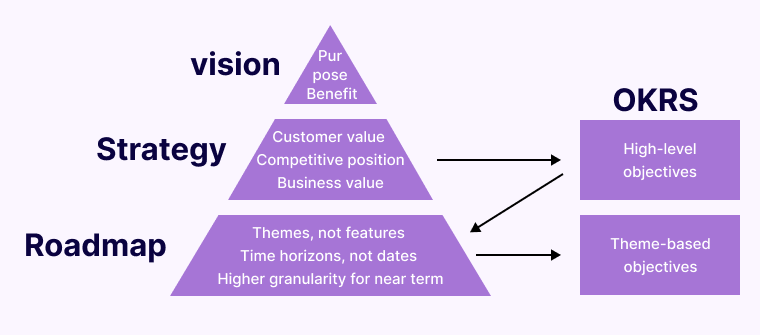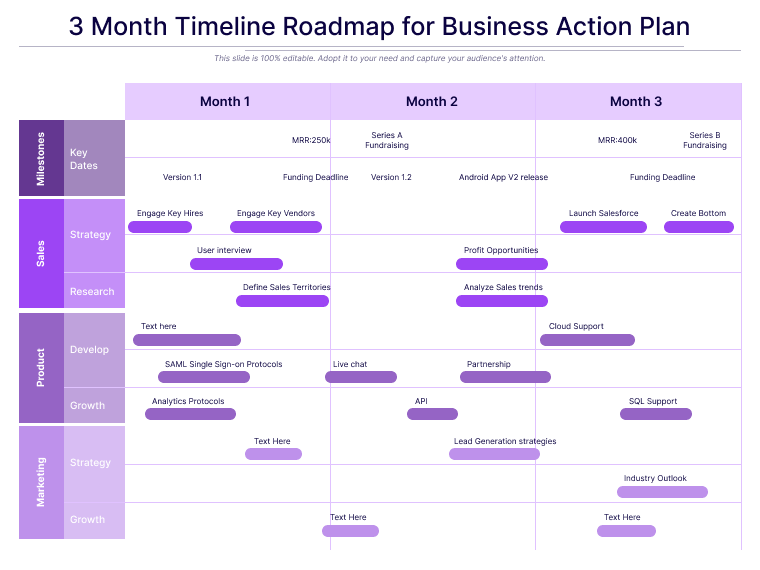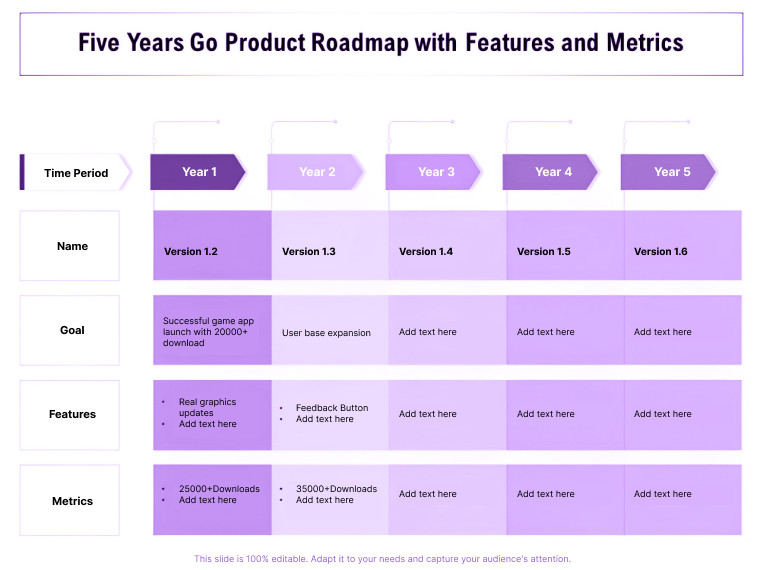A software development roadmap is necessary for expressing how short-term efforts are aligned with long-term business objectives. Understanding the purpose of a roadmap, as well as how to construct one that works, is critical for keeping your team on track.
Software Development Roadmap

A product roadmap is a high-level visual overview of a company’s product’s vision and strategic goals. A software roadmap is a plan that is tailored to a particular software product.
When do you need One?
A logical sequence of steps is followed in the software product development, just as it is in the development of any other form of the product.
A company’s product vision is established first. This vision is translated into a blueprint by the product team, which contains a long-term view of the product’s strategic goals and themes.
The product roadmap stage is currently in progress. Finally, the roadmap’s high-level plan will be translated into concrete tasks by a cross-functional team of project managers, engineers, and other organizations.
A useful software product manager needs a roadmap to serve as a link between the company’s product vision and the responsibilities involved in bringing that product to market.
Who is in charge of developing a software development roadmap?
Typically, the product manager is in charge of creating a software development roadmap. They put it together based on the company’s vision and strategy and then communicate it to the other production teams. It is a movable item, so you can use it as needed.
Essential Elements of a Product Roadmap
Many important variables should be covered in your product roadmap and product plan because they must span a long period of time. Along with vision and strategy, product characteristics must be highlighted.
Vision for the Product

This is a crucial element because it puts your organization on the right track to developing a product strategy. It is a vision of what is wanted and what it can achieve.
This initial vision does not have to be the ultimate one; rather, it kicks off the process of developing a product roadmap, allowing for future planning. This specifies what you want your final product to be.
Plan of action

This is the prospectus for the product that you create. Internal and external stakeholders should be aware of the project’s ultimate business aim. Describe how this product will help the company and how it will fit into the overall vision. Once all of these elements are in place, the roadmap is utilized to keep the plan on track and consistent.
Prerequisites
You must gather information in order to establish your requirements. Consult your sales and customer service teams. They are aware of how your customers feel about current items, what they want, and any feature requests.
This allows you to prioritize which features should be included in future product releases. Reach out to user experts to engage with those who are already using your products.
Use your personal experiences after these two groups. You understand the functioning, features, and other aspects of your product, as well as what users require.
Also Read: Software Ideas for Startups In 2024
Product Development Plan

The product plan is a method for ensuring that the product vision is realized by your firm. It is the strategy for carrying out the plan as the project moves forward. Prioritize and create specific targets on this schedule.
It should be broad enough to allow for flexibility and creativity, but it should also include some broad time objectives. To guarantee that initiatives are finished on time, plan them on a quarterly or monthly basis. Dates are useful in general, but they should not be taken literally.
Markers
When it comes to keeping everyone in the know about time, they are crucial. Even if you do not have exact dates, understanding where the markers are to measure the development of the project is critical to going forward.
Markers can be moved around as needed, but having them visible allows others to check on timelines as needed.
Metrics

Ascertain that all teams are aware of the metrics and that everyone is measuring things in the same manner. Everyone must speak the same language in order for the measurement to be clear.
Steps to create a Software Development Roadmap

A strategic sequence of stages should be followed while creating a roadmap. A high-level checklist for creating your first roadmap from scratch is as follows:
Step 1: Determine the “Why” of your product.
You must first define the product’s strategic rationale for existence before deciding how to prioritize its features or any other specifics. You should understand why you intend to produce the product, what you hope it will achieve, and who it will serve.
Your responses to these initial questions will drive all of your other strategic decisions about how to construct the product.
Step 2: Determine the target audiences for your roadmap

You cannot establish a single version of your software product roadmap to communicate with all audiences or develop it in a vacuum.
The high-level strategic objectives should be the emphasis of your executive team’s roadmap presentation.
Your executives will want to know how adding a feature will help you achieve broad business objectives like growing revenue or improving your company’s reputation.
When reviewing the roadmap with your developers, on the other hand, you will be more concerned with how your goals will affect the development team’s resources and workloads.
Also Read: Estimate Custom Software Development Costs for Your Project
Determine who will be viewing your software roadmap. This will allow you to adjust both the roadmap and your presentation to those different audiences.
Remember: You should only make one version of your product roadmap so that you can simply switch between views or degrees of detail. You do not need to rewrite your roadmap for each target audience. Using roadmap software is the simplest way to accomplish this.
Step 3: Prioritize the strategic topics of your product

It is now time to start writing your roadmap’s content. When creating a roadmap, the ideal practice is to start at the highest, most strategic level. Then you can fill in the blanks with additional particular information.
You will begin by categorizing the primary planned topics for your product in this section. Then, for each theme, you may add multiple epics. You can also include any other details you have in mind, such as specific features for an epic.
Step 4: Review and update your roadmap on a frequent basis.
Since product development might take unexpected twists, you should review your software roadmap on a frequent basis to ensure that your team is still on pace to meet your strategic objectives.
It is critical to be adaptable and ready to adjust your roadmap if circumstances change or priorities shift.
Your software development roadmap is not supposed to be a static document. A roadmap update does not imply that your team overlooked something or that you made a mistake. It is often only a required step on the way to effectively launching a product on the market.
Tips for Software Development Roadmap
Tip #1: Get Early Buy-In

All internal teams that will be involved in the project should be included in your product map. You need their buy-in to your development roadmap if you want their help.
Not only should the product roadmap cater to your team’s interests, but it should also cater to theirs. Include the following information:
- Execs and upper management: Share your product plan and market statistics with them.
- Marketing Team: Give the marketing team information on the product’s features and how it compares to similar products on the market. Inform them of the product’s potential to produce revenue.
- Sales Team: Ensure that the roadmap includes broad release dates (rather than firm deadlines) as well as the benefits that the product will provide to its customers.
- Engineer and Development Team: Make a list of the requirements, timelines, and tasks that must be completed. If necessary, you can create a product development roadmap specifically for these teams.
Since this is all part of a single roadmap, use mapping software that allows you to highlight information for each team while keeping everything on the same schedule.
Tip #2: Share it with others
It is time to distribute the roadmap to the teams once you have finalized it. This engages everyone and makes it easier for upper management to approve the plan.
It outlines all of your planning accomplishments as well as your next steps. Sharing ensures that everyone is aware of the plan and that teams are held accountable and informed.
Advantages of creating a Software Development Roadmap?
It enables your engineers to comprehend how their work fits into the wider picture
When you provide custom software development services team access to your roadmap, they can see how their work affects the overall product.
Your development team will be more motivated if they have access to your roadmap. Your developers will experience a better sense of participation and purpose when they realize how their coding activities assist shape the product—and ultimately enhance the lives of the product’s consumers.
It enables the team to make better priority decisions
Product development rarely follows a predictable, linear path from project start to market launch, no matter how well-planned it is. The resource levels of the squad can alter at any time.
Budgets can be frozen with little or no notice by senior management. Different needs from other parts of the company can take precedence over product development at any time.
When a product team is confronted with these unanticipated changes, having a well-thought-out product roadmap might be beneficial. The roadmap helps the team to take a step back, examine its high-level goals, and make the required resource reprioritization decisions.
It can assist you in persuading your stakeholders
Showing your executive team merely a list of planned features without a strategic rationale for why you have chosen to build your product in that particular method may not be enough to convince them to approve your plan. To move forward, most product teams require the approval of that executive.
With this in mind, a well-crafted product roadmap can also be used to communicate and persuade others. It can assist a product team in presenting a compelling strategic strategy to the company’s leadership, allowing the team to begin building their product.
Sharing Your Completed Software Roadmap: Some Pointers
You have finished your roadmap and are ready to deliver it to one or more groups. So, what is next for you?
The following are the seven steps they recommend for preparing your roadmap presentation:
Topic
What is the subject of your talk? Will you be working with a cross-functional team to discuss product strategy, seeking permission from senior management or investors, and so on?
Situation
What will you say, how will you say it, when will you say it, and where will you say it? Will it be a stand-alone talk of the product roadmap or will it be part of a larger event? What impact might this have on the way you deliver your presentation?
Target audience
Who are you going to tell about your plan? What effect will this have on the sequence in which your strategy and plans are presented? What level of specificity do you intend to display?
Goal
What exactly are your objectives for this presentation? Do you require permission to proceed, to ensure that your development team understands your aims, or to achieve other strategic goals?
Prior to Presentation
What other documents or information should you have on hand for the presentation? Will you need additional data and evidence to back up your strategic plans or revenue forecasts, for example?
Will you want to enlist the help of subject-matter experts from other departments to respond to issues that arise during your presentation?
Handling objections
What types of objections do you expect your audience to raise during your roadmap presentation, such as projected dates, budgets, and expected ROI? What can you do to get ready to deal with those objections effectively? Could you raise them yourself, ahead of time, during the presentation?
Put it into action
What other methods and approaches can you employ in order to create the most captivating roadmap presentation possible?
Conclusion
Is it possible for a modern IT organization to function without a roadmap? Yes, most likely. However, there are some legitimate concerns about completing projects on time without a plan.
Product owners and managers can use the right product software development strategy to deliver their outstanding products on time, with the right functionalities and lowest costs.









